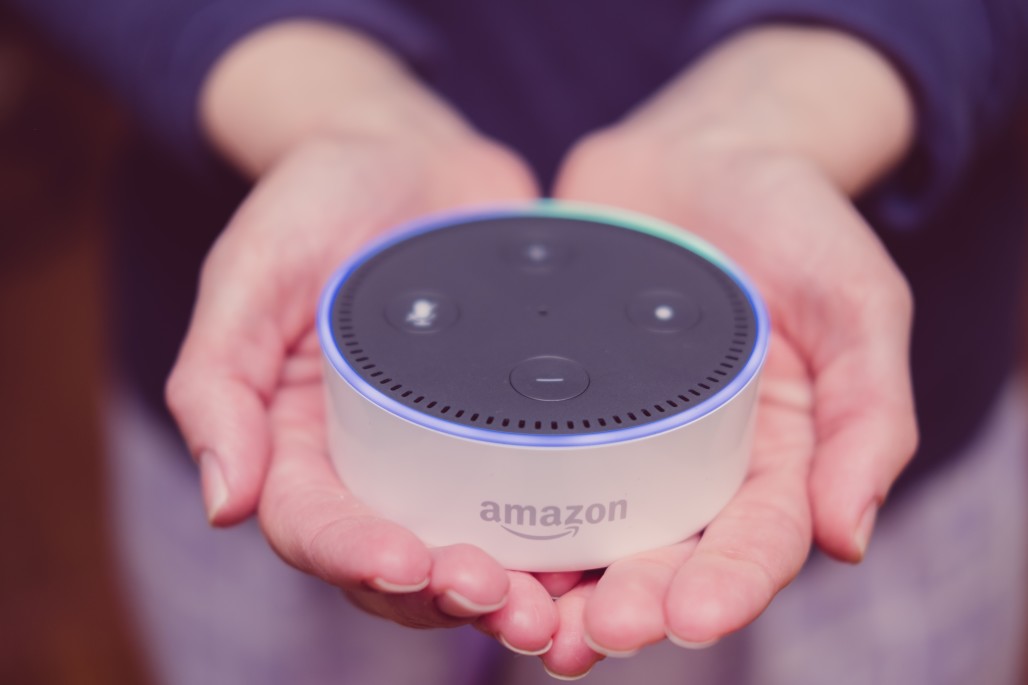With Voice Search on the rise, it’s time to rethink your Content & SEO strategy.
Voice Search is changing the game when it comes to content and SEO strategy. And whilst some may be seeking to shelve their plans to renovate their approach in favour of what they think are more pressing concerns, the smart ones are watching what’s going on they’re taking action now.
In my own research on this it was hard to find a lot of detail from either Google or Amazon on just how well their ‘smart speaker’ sales have gone in ANZ so far this year (2019). But when you take a look at the trajectory of device sales more broadly & the volume of voice generated search queries the view really is staggering.
If you start to paint the picture from way back in the early 2000’s, (our beloved) Mary Meeker showed in her 2016 report that voice searches had grown by over 35 x in the 8 years leading up to that.
By 2017, Location World reported that more than 40% of adults were using voice search on daily basis, and by 2018 data from the analytics firm Canalys that between Google and Amazon, they shipped over 9 million units of their smart speakers to paying customers in the first quarter (Jan-Mar) alone.
Closer to home (here in AU), Managing Director of Telsyte, Foad Fodaghi in May last year (2018) estimated around half a million Australian households currently own a smart speaker, and that was mainly Google Home devices as they had first mover advantage and got the jump on Amazon in our local market.
Nonetheless, the Telsyte report forecasts that number will grow to around 3 million by 2022. That’s 600% growth in 3 years!
So what’s driving the massive uptake from a UX & business model perspective?Well, like any good platform there are always two sides to the story (cough). On one side, you have the UX, voice is fast and easy, and once accuracy ratings for the technology clicked above 95%, it was an absolute turning point. Human accuracy runs around that number, so the difference from a UX perspective in going from 90% to 99% is pivotal.
Personalised, context driven, and keyboard free.
That’s the future of search in my opinion, it’s the ability for this new technology to understand the wider context of search queries, based on prior questions, location, previous interactions, semantics and more that give it real power.
And with 600% growth forecast over the next few years, you can expect every second ad to be from Google or Amazon again this Christmas.
So what does this all mean for your own digital and content marketing plans this year?
Firstly let’s the assumption that you’re up to speed on all the vanilla items that punctuate every good content strategy when it comes to SEO. Building your content library, basing the production on some solid keyword research, manufacturing a range of evergreen and topical content across a range of mediums (article, video, etc) to keep you pushing up the ranks in Google’s organic search results.
The good news is that in order to tackle voice, you don’t have to throw the baby out with the bathwater (so to speak). There’s nothing about your current practice that you have to ‘undo’ necessarily. The better way to view it is that by having that foundation in place, and your general content machine running smoothly, it puts you in a position to try something new, to evolve, and to get a little more ambitious in your strategy, and accurate in your execution.
The first point to note when creating content for voice, is that the searches are far more likely to use full sentences, spoken in more natural language. Currently when you create content for your business, you’re probably able to retro-fit individual keywords or short phrases into your content that give it some stronger search performance, but perhaps becomes a little jarring for the user reading it. However with voice search, those keywords and phrases will more likely be communicated as part of a full sentence, as the user interacts with an intelligent agent (Siri, or Alexa) more like they do with another human, than they do with a Mac or PC.
Also worth noting that when it comes to younger users (ie: teenagers), they’re far more likely to use natural phrasing with an intelligent agent than they would use to make the same search with a keyboard (or keyboard on their phone if we’re talking about my kids).
Smart marketers are taking this opportunity to focus more on their users own specific needs, leveraging the personalisation of voice to tailor content to more specific user requirements. You see, voice is less about high-volume keywords, and more about providing users with the information they seek, when and where, and how they seek it.
Or as Google puts it, …”finding the moments that matter.”
4 x key moments that marketers should keep in mind when their planning to target specific user groups are;
- I want to know
- Deepening the customer experience and allowing them to move along the path to purchase
- I want to go
- 500% increase in searches ending in “near me” (ref: Lisa Gevelber)
- I want to do
- Over 100M hours of “how to” content watched on You Tube each year + 91% of smartphone users turn to their phone for ideas while doing a task.
- I want to buy
- 82% of smartphone users consult their phones while in store deciding what to buy. (the path to purchase has changed, forever)
Voice search is fast, easy, and increasingly mobile, meaning that it is also increasingly location driven. Google’s VP of Marketing for the Americas Lisa Gevelber was quoted saying “near me” searches are no longer just about place, but about time and things as well.
Localing content to increase SEO performance has always been part of any good content marketing strategy, but when it comes to voice, it’s even more important.
In particular for small businesses, or corporations that provide local products and services, users will simply request a search that is “near them”, “Siri, where is the nearest Australia Post outlet?”
In order to raise your ranking for these search terms, it’s critical that you focus on local SEO: claiming your listing from Google My Business, building local keywords into your search terms, using local structured data, and increasing your locally-based information within the content.
The content strategists among us know that when you create content to target keywords that are highly specific, you’re providing crucial information for those users higher up up the funnel, and that is the kicker when it comes to voice, as most of us see search as a tool that brings users into our purchase funnel much further down, after all, organic search is great quality traffic. But the reality is that due to the nature of voice being mobile, fast, easy, here and now, users are far more likely to use it before they have necessarily gone all the way along the buying journey. As users move along the path to purchase, they’re more likely to use more traditional search techniques that yield a deeper, more informative and more detailed experience.
So by focussing your attention on the needs of your users rather than the needs of the search organic searchrithm (via keywords) you start to transform the way you engage with prospective new customers through search.
Conversational, natural language, using long tail keywords starts to become one of the most effective ways to reach your audience, as those are the terms that are used most often, and in that context, through voice search.
The next item to tackle are your Persona’s, and it’s worth taking a moment to personify them as much you can, or dare I say humanise them (if that’s a word).
What is the natural language of your target audience? Do you know them well enough to form content that will resonate with them, not just on subject matter, but in context, style and colloquial terms?
You can see that it starts to get a little more complex as you move along. Google will always keep evolving their organic search algorithm to ensure they’re giving their users the best possible experience they can. After all that is the central pillar holding up over ¾ of their revenue. So they survey things like grammar, and correct pronunciation, and the specificity of a particular question, then deliver their organic search results as best as they can to meet the users perceived need.
As an example, they may publish different search results for an someone who speaks academically, vs someone who is more colloquial, even though they’re both speaking English.
When you look to evolve your current content approach with voice search now in mind, you need to consider the types of people who would likely be using voice in the first place. If one of your buyer persona’s are for a 65+ age group, are they really early adopters as well? Could be, could be not. You need to rethink your persona’s with this in mind, and then seek to create content that is aligned with their wants and needs. (My Dad still hasn’t even made it from DVD to Apple TV, but American Express still send him something in the post every month)
However, last but not least are the new “featured” snippets that you can see on the bottom of your screen underneath Google’s organic search results for any particular query. I can tell you from a publisher’s perspective, having your content featured in that box, goes a long way toward you hitting your audience target for the month.
By doing some in depth keyword research & analysis around query volumes for particular times of the year, you can really start to understand what questions your users are asking, and importantly, when.
Because of this, FAQ web pages are on the rise as part of a more complete digital strategy to provide all types of content. Whether these FAQ pages are a stand alone piece of content (ie: such as a downloadable PDF’s) or simply catered for within a blog post, they can become rivers of gold in generating high quality, bottom of funnel search traffic, as the user looks to find answers to common questions, and simultaneously allows your business to provide that information to users.
If you are aspiring to rise through the ranks on search page results, even when you fully embrace the voice search trend, there’s no single magic bullet that is going to instantly triple your business overnight. It’s about hard work, persistence, and importantly being consistent in your approach.
But, if the forecast on growth for device ownership in this category is anything to go by, there’s a fair bit of digital transformation left to run in consumer land. And one thing i do know for sure is that sooner or later we’ll all have to consider voice in our strategy development, and in our content creation.
Stu Stevens
MD & Founder of Remap Online
(Stu was previously Head of Development for Yahoo! Inc in ANZ, and Director of Digital for Bauer Media AU)




